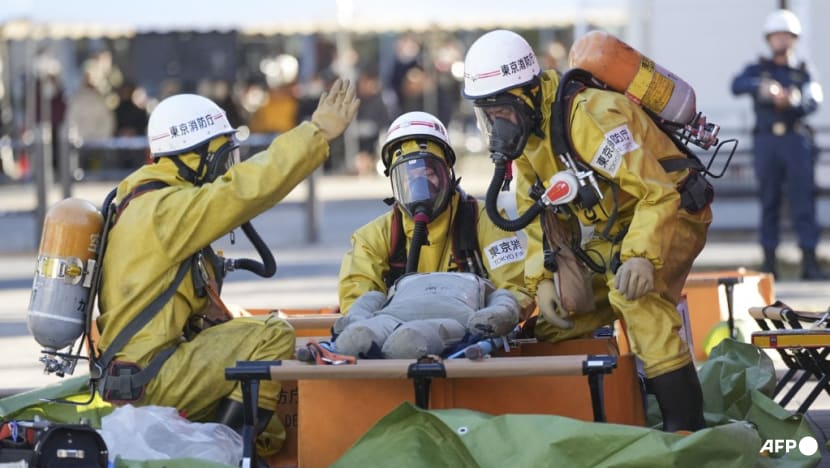Commentary: A prophesied disaster likely won’t strike Japan this weekend
Despite advances in tectonic science, earthquakes can’t be predicted. But perhaps there’s something to be said for keeping people on their toes, writes Gearoid Reidy for Bloomberg Opinion.

File photo. Firefighters wearing protection gear take part in a drill in Tokyo, Jan 15, 2024. (Photo: AFP/Toru Hanai/ Pool)

This audio is generated by an AI tool.
TOKYO: Life as we know it will probably not come to an end in Japan this weekend. But what if it does?
That’s the question consuming a disaster-prone country ahead of a widely spread prediction of disaster that one comic book suggests will occur this Saturday.
Watashi ga Mita Mirai (The Future I Saw), a manga by Ryo Tatsuki about her purported ability to see the future in dreams, was first published in 1999. It would have faded into obscurity but for the mention of a tsunami, and the cover that read “Major disaster in March 2011”.
Years later, when the most powerful earthquake ever to hit the country struck that very month, triggering a devastating tsunami and the Fukushima Dai-ichi nuclear meltdown, some hailed the author as a prophet.
In 2021, she released an updated version that included a new prediction of disaster on Jul 5, 2025, involving a massive eruption in the Philippine Sea that triggers a tsunami striking Japan with waves three times the height of 2011.
Such a disaster would obviously be devastating on a human level. But already, the comic has had an economic impact, with some tourists from Hong Kong and elsewhere in Asia shunning trips out of fear. Takahide Kiuchi, executive economist at the Nomura Research Institute, estimates that ¥560 billion (US$3.9 billion) of economic damage could result if tourists continue to stay away due to this and other projections of doom.
CAUTION QUICKLY TURNS TO COMPLACENCY
As Jul 5 approaches, it’s becoming more talked about domestically; I’ve been asked about it in bars and overheard its mention in coffee shops. A series of hundreds of relatively small quakes off the southern island of Kyushu over the last two weeks has kept disaster in the headlines. The manga has sold over 1 million copies, while another book by Tatsuki is topping the charts.
Of course, despite advances in tectonic science, earthquakes can’t be predicted. The Japan Meteorological Agency has taken to social media to caution that “any such predictions should be considered unreliable”.
But that message is muddled by the fact that the agency and the government believe that harbingers of the dreaded Nankai Trough megaquake can be detected. That resulted in a chilling official announcement last year about the elevated risk of a disaster that is estimated to kill as many as 300,000 people.
That episode briefly had much of the country on edge. The next day, the country’s earthquake early warning alert was triggered, an automated signal that gives notice of an imminent big quake, piped straight to smartphones and trains. Sitting with colleagues in a bustling bar on Friday evening, the chill that went through the room was palpable, as dozens of phones blared shrill messages of EARTHQUAKE! EARTHQUAKE! and we wondered if this was, indeed, the end.
Nothing happened. The alert was a false alarm. There’s something to be said for keeping people on their toes: While mercifully the Nankai quake did not hit last year, the threat remains undiminished. The government’s alert prompted many (myself included) to prepare or restock disaster supplies, with Japan’s rice shortage partly blamed on the spike in demand it caused. But caution quickly turns to complacency.
DISASTER WILL HAPPEN AT SOME POINT
The idea that we can predict the future is an attractive one, promising certainty in an uncertain world. That helps overcome the litany of failed prophecies, from Nostradamus’s warnings in 1999 to the Maya doomsday theories in 2012.
Some that do turn out to be true - think the 1988 Japanese animated movie Akira’s prediction that Tokyo would host the 2020 Olympics - are just examples of survivor bias. We forget those that don’t come to pass, remembering only those that do, presumably including Tatsuki’s 2011 reference.
But when it comes to Japan, past predictions of doom - such as a “hidden planet” Nibiru crashing into Earth, or a supermassive black hole at the galaxy’s center causing havoc - aren’t good comparisons. A catastrophe not dissimilar to the one Tatsuki describes really could take place at any time - Jul 5, or any day before or after. Indeed, according to government estimates for the Nankai Trough quake, it’s more likely than not to happen in our lifetimes.
Nonetheless, even in Japan many are still taken by surprise. Media focus on major disasters such as a quake hitting directly under Tokyo can lure those elsewhere into a false sense of security. Few, including the operators of the Fukushima nuclear plant, were sufficiently prepared for a quake off the coast in 2011 - despite extensive records showing past disasters.
On Jul 5, when nothing happens, what then? My guess is most will just shrug and move on, perhaps a little embarrassed for having believed it, or a little better prepared than they otherwise would have been. People might turn on Tatsuki, who has already distanced herself from the exact date. She may pop up again with another prediction - or fade back into obscurity.
Regardless, the message that we should prepare for disaster is one we should listen to. In all probability, the earthquake won’t happen on Jul 5. But it will happen sometime. That’s a warning we should all heed.









